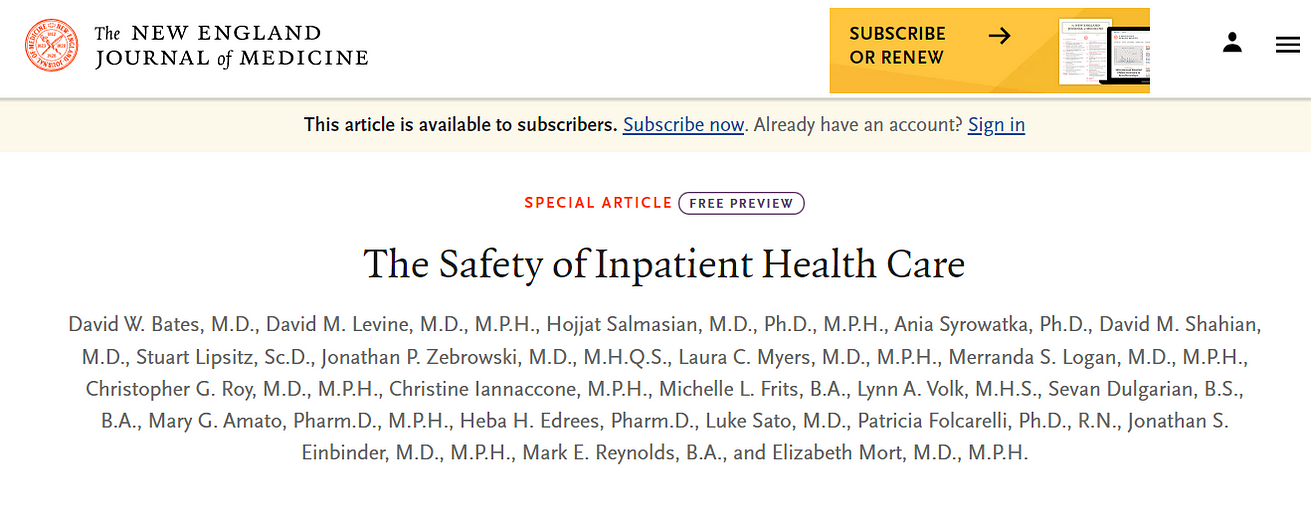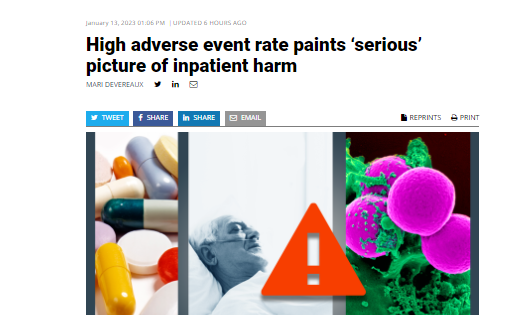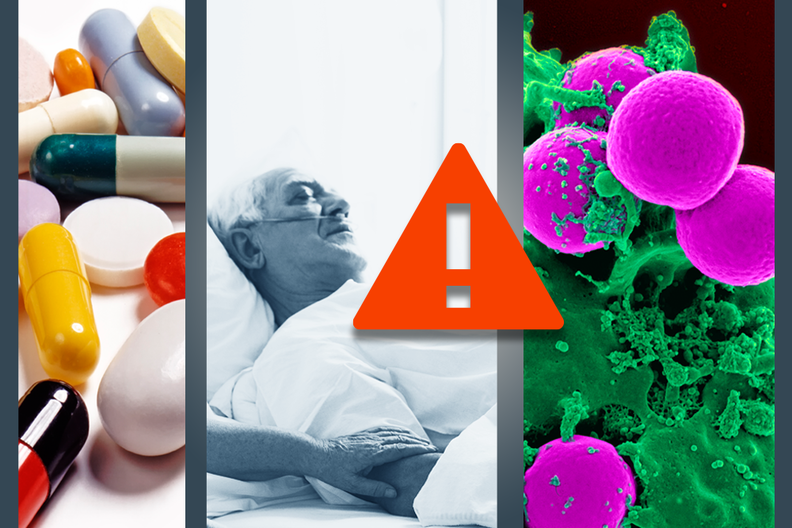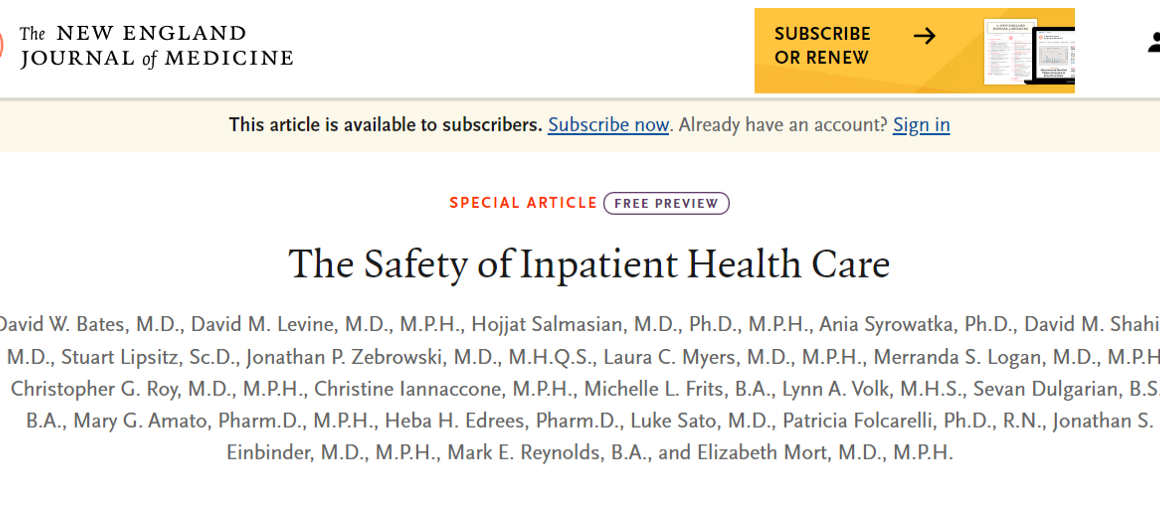This is a republication of the paper “The Safety of Inpatient Health Care”, with the title above.
the health transformation
institute
institute for continuous health transformation
Joaquim Cardoso MSc
Chief Researcher, Editor and
Senior Advisor
January 14, 2023
KEY MESSAGE(S)
A study in 11 Hospitals in the US found that adverse events during hospitalization are a major cause of patient harm.
- The study conducted a retrospective cohort study to assess the frequency, preventability, and severity of patient harm in a random sample of admissions from 11 Massachusetts hospitals during the 2018 calendar year.
- The study found that adverse events were identified in nearly one in four admissions, and approximately one fourth of the events were preventable, …
- … highlighting the importance of patient safety and the need for continuing improvement.
Adverse drug events were the most common adverse events (accounting for 39.0% of all events), …
- … followed by surgical or other procedural events (30.4%), …
- … patient-care events (which were defined as events associated with nursing care, including falls and pressure ulcers) (15.0%), and …
- … health care–associated infections (11.9%).
There were seven deaths, one of which was deemed to be preventable.
DEEP DIVE

The Safety of Inpatient Health Care
NEJM
David W. Bates, M.D., David M. Levine, M.D., M.P.H., Hojjat Salmasian, M.D., Ph.D., M.P.H., Ania Syrowatka, Ph.D., David M. Shahian, M.D., Stuart Lipsitz, Sc.D., Jonathan P. Zebrowski, M.D., M.H.Q.S., Laura C. Myers, M.D., M.P.H., Merranda S. Logan, M.D., M.P.H., Christopher G. Roy, M.D., M.P.H., Christine Iannaccone, M.P.H., Michelle L. Frits, B.A., Lynn A. Volk, M.H.S., Sevan Dulgarian, B.S., B.A., Mary G. Amato, Pharm.D., M.P.H., Heba H. Edrees, Pharm.D., Luke Sato, M.D., Patricia Folcarelli, Ph.D., R.N., Jonathan S. Einbinder, M.D., M.P.H., Mark E. Reynolds, B.A., and Elizabeth Mort, M.D., M.P.H.
BACKGROUND
- Adverse events during hospitalization are a major cause of patient harm, as documented in the 1991 Harvard Medical Practice Study.
- Patient safety has changed substantially in the decades since that study was conducted, and a more current assessment of harm during hospitalization is warranted.
METHODS
- We conducted a retrospective cohort study to assess the frequency, preventability, and severity of patient harm in a random sample of admissions from 11 Massachusetts hospitals during the 2018 calendar year.
- The occurrence of adverse events was assessed with the use of a trigger method (identification of information in a medical record that was previously shown to be associated with adverse events) and from review of medical records.
- Trained nurses reviewed records and identified admissions with possible adverse events that were then adjudicated by physicians, who confirmed the presence and characteristics of the adverse events.
RESULTS
- In a random sample of 2809 admissions, we identified at least one adverse event in 23.6%.
- Among 978 adverse events, 222 (22.7%) were judged to be preventable and 316 (32.3%) had a severity level of serious (i.e., caused harm that resulted in substantial intervention or prolonged recovery) or higher.
- A preventable adverse event occurred in 191 (6.8%) of all admissions, and a preventable adverse event with a severity level of serious or higher occurred in 29 (1.0%).
- There were seven deaths, one of which was deemed to be preventable.
- Adverse drug events were the most common adverse events (accounting for 39.0% of all events), followed by surgical or other procedural events (30.4%), patient-care events (which were defined as events associated with nursing care, including falls and pressure ulcers) (15.0%), and health care–associated infections (11.9%).
CONCLUSIONS
- Adverse events were identified in nearly one in four admissions, and approximately one fourth of the events were preventable.
- These findings underscore the importance of patient safety and the need for continuing improvement.
(Funded by the Controlled Risk Insurance Company and the Risk Management Foundation of the Harvard Medical Institutions.)
Originally published at https://www.nejm.org
About the authors & affiliations
David W. Bates, M.D., David M. Levine, M.D., M.P.H., Hojjat Salmasian, M.D., Ph.D., M.P.H., Ania Syrowatka, Ph.D., David M. Shahian, M.D., Stuart Lipsitz, Sc.D., Jonathan P. Zebrowski, M.D., M.H.Q.S., Laura C. Myers, M.D., M.P.H., Merranda S. Logan, M.D., M.P.H., Christopher G. Roy, M.D., M.P.H., Christine Iannaccone, M.P.H., Michelle L. Frits, B.A., Lynn A. Volk, M.H.S., Sevan Dulgarian, B.S., B.A., Mary G. Amato, Pharm.D., M.P.H., Heba H. Edrees, Pharm.D., Luke Sato, M.D., Patricia Folcarelli, Ph.D., R.N., Jonathan S. Einbinder, M.D., M.P.H., Mark E. Reynolds, B.A., and Elizabeth Mort, M.D., M.P.H.
Author Affiliations
From the Division of General Internal Medicine and Primary Care, Brigham and Women’s Hospital (D.W.B., D.M.L., H.S., A.S., S.L., C.I., M.L.F., S.D., M.G.A., H.H.E., L.S.), the Department of Health Care Policy (E.M.), Harvard Medical School (D.W.B., D.M.L., H.S., A.S., D.M.S., S.L., J.P.Z., M.S.L., H.H.E., L.S., E.M.), the Department of Health Policy and Management, Harvard T.H. Chan School of Public Health (D.W.B.), the Edward P. Lawrence Center for Quality and Safety (D.M.S., J.P.Z., E.M.), the Division of Cardiac Surgery, Department of Surgery (D.M.S.), the Department of Psychiatry (J.P.Z.), the Division of Nephrology (M.S.L.), and the Division of General Internal Medicine (E.M.), Massachusetts General Hospital, and the Controlled Risk Insurance Company and the Risk Management Foundation of the Harvard Medical Institutions (L.S., P.F., J.S.E., M.E.R.) — all in Boston; the Kaiser Permanente Northern California Division of Research, Oakland (L.C.M.); Maine Medical Center, Portland (C.G.R.); and Mass General Brigham, Somerville, MA (L.A.V.).
RELATED ARTICLE

Modern Healthcare
MARI DEVEREAUX
January 13, 2023
Excerpt
…
“It’s a serious, high rate of harm,” said Dr. Peter Pronovost, chief quality and clinical transformation officer at University Hospitals in Cleveland, who was not involved in the research.
“What’s troubling is that we don’t seem to have a great trend, despite a couple of decades of working on this stuff.”
The findings are similar to those detailed in an Office of Inspector General patient harm report released in May. That report found one in four Medicare patients experience patient harm during short-term, acute-care hospital stays.
Though some patient safety measures like those around infection control have gradually improved, there has not been drastic improvement in outcomes since the publication of the 1991 Harvard Medical Practice Study, which raised the alarm nationwide on the topic of patient safety, Provonost said.
Though some patient safety measures like those around infection control have gradually improved, there has not been drastic improvement in outcomes since the publication of the 1991 Harvard Medical Practice Study, which raised the alarm nationwide on the topic of patient safety, Provonost said.
The current study found seven deaths were the product of harm events, one of which was labeled as preventable.
Adverse drug events accounted for 39% of all events; surgical or other procedural events comprised 30.4%; patient-care events, including falls and pressure ulcers, accounted for 15%; and healthcare-associated infections were 11.9%.
Out of all patient admissions, 6.8% experienced a preventable adverse event and 1% experienced a preventable adverse event with a severity level of serious or higher, researchers found.
The study was funded by a grant from the Controlled Risk Insurance Company of Vermont and the Risk Management Foundation of the Harvard Medical Institutions.
Over the years, health systems have worked to improve medication safety …
… by instituting barcodes, computer order entry and smart pumps, which is why the number of adverse drug events is surprising, said Dr. David Bates, the study’s lead author and chief of general internal medicine at Brigham and Women’s Hospital.
Over the years, health systems have worked to improve medication safety … by instituting barcodes, computer order entry and smart pumps, …
… which is why the number of adverse drug events is surprising,
“It’s concerning,” he said. “The rates are higher than I thought they might be… It’s still very clear that patient safety is a big issue and it’s one that institutions and leaders need to pay attention to.”
It’s still very clear that patient safety is a big issue and it’s one that institutions and leaders need to pay attention to.”
More providers should focus on developing stronger decision support and leveraging free programs like Fall TIPS, an evidence-based intervention that uses bedside tools to communicate risk factors and creates tailored plans to prevent falls, Bates said.
More providers should focus on developing stronger decision support and leveraging free programs like Fall TIPS, an evidence-based intervention that uses bedside tools to communicate risk factors and creates tailored plans to prevent falls, Bates said.
It’s also important for hospitals to use electronic health record data to look for signals that a patient may have had a harm event and identify areas to intervene earlier in patient care so harm doesn’t occur, he said.
More providers should focus on developing stronger decision support and leveraging free programs like Fall TIPS, an evidence-based intervention that uses bedside tools to communicate risk factors and creates tailored plans to prevent falls, Bates said.
It’s also important for hospitals to use electronic health record data to look for signals that a patient may have had a harm event and identify areas to intervene earlier in patient care so harm doesn’t occur, he said.
“Hospitals need to begin to measure the frequency of all types of harm that occur so that they can figure out which areas of harm they should prioritize at any given time,” Bates said.

Ultimately, the rate of adverse events across health systems is a reflection of the lack of investment in sustainable systems for quality and safety, said Stephanie Mercado, CEO of the National Association for Healthcare Quality.
When systems don’t have coordinated workforce support systems, there is little to no training to inform workers about what a safety event is, how to identify one and how to solve for them at a patient and system wide level, she said.
“We need to move from compliance with quality and safety standards, to this notion of excellence in quality and safety,” Mercado said.
“Compliance represents a collection of activities that were developed as a result of something going badly, and excellence is much more aspirational and will help us achieve a future state where quality and safety are both the process and the outcome of our efforts.”
“We need to move from compliance with quality and safety standards, to this notion of excellence in quality and safety,”
“Compliance represents a collection of activities that were developed as a result of something going badly, and excellence is much more aspirational and will help us achieve a future state where quality and safety are both the process and the outcome of our efforts.”
RELATED ARTICLES










